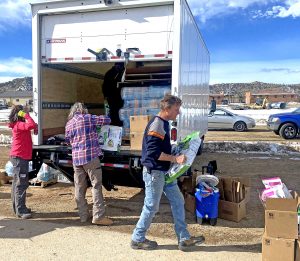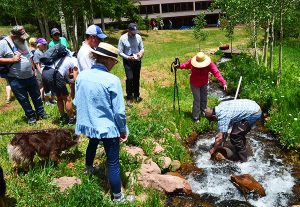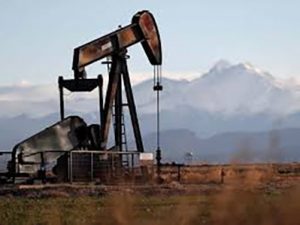Hard work, tough men, explosions, and more
by Nancy Christofferson
ALAMO — There’s a big difference between being a Texan and being a Huerfano when someone reminds you to “remember the Alamo”.

In Texas, one conjures up the image of a dusty, falling down old mission where a desperate battle took place. In Huerfano County, if you ask a person of “a certain age”, he or she would recall the picturesque model coal camp northwest of Walsenburg, where hard working people lived, worked and raised their children.
The Alamo mine was just a few miles southwest of the working mines of Tioga and Delcarbon located on Highway 69 when it was developed in late 1922 by the Oakdale Coal Company. It opened soon after and a post office was established February 21, 1923, or 95 years ago this week. Construction on the workings and camp structures continued that spring and summer until the first coal was pulled in October. By that time, about 20 homes had been built and by the end of 1923, there were nearly 100 residences, a school and addition and many mine buildings.
The camp itself was built on a “small mesa” east of the mine entrance. The buildings were all of brick, because, it is said, the camp had its own factory. The original houses had four rooms each, with front and back porches, and were wired for electricity. They had no indoor plumbing, but there were hand pumps out front that were shared between two residences. Water service was provided from a well in Dog Springs Arroyo with a reservoir that pumped the water to a storage tank on a hill overlooking camp.
The first fatalities in the mine occurred in early March 1923, when two men were struck and killed by a mine car. It seems odd, but the Alamo saw more injuries and fatalities from accidents than from the usual cause of death in coal mines – falls of rock or roof and explosions. However, the fire boss himself was killed in the latter in the summer of 1924, along with some mules, and an explosion in the new Alamo mine on Thanksgiving Day 1942 killed three. Otherwise, we find men killed when run over by or thrown from mine cars, in runaway cars, and being caught between cars and roofs or supports.
Oakdale Coal Company owned and operated the mine at Oakview camp west of La Veta. The Oakdale coal mine prided itself on having superior, hard coal that burned clean. At the time the Alamo was opened, the Oakdale was producing again but had been closed during a miners’ strike in 1921-2, and the miners’ wages had been reduced. All this resulted in the imposition of martial law and the arrival of state rangers, who stayed for many months. Then the company was sued by its neighbor, the Ojo Reliance mine, for “infringement and careless operations which caused the collapse of underground workings”. Along the way, Oakdale suffered a fire and flood inside. Operations were merely part time between 1922 and ’25.
Alamo and Oakdale shared a superintendent. In 1924, when the Oakdale was on part time status, one McLearey was in charge of the two mines. He was one very embarrassed and relieved official in late December after he set off in a snowstorm from Oakview for Alamo and failed to arrive. A large search party set out and eventually discovered him sheltering in an old dugout four miles from Alamo, where he had wandered, lost in the storm and disoriented.
In 1926 the company developed a second mine, called Alamo Number 2 or Barbour. It soon had 32 homes and 75 employees. This camp too was considered picturesque and well situated. Its first fatality was in November ’26 when a 26-year-old miner was killed by a fall of rock.
As Alamo kept growing, new roads from Walsenburg and La Veta were built into the camp. The Denver and Rio Grande Western Railroad extended its Loma Branch and built a spur up the canyon from the Kebler mines at Tioga to Barbour and Alamo.
In 1927, Trinidad Electric built electrical lines into the camps. By that time, the company was providing power through its own plant, but this was mostly directed toward the operation of the mine rather than to the homes and school.
The Alamo school, District No. 50, started off in 1924 with one teacher, who was quickly relieved by the addition of another. By the next year there were three, and in 1930 there were four, one of whom was a young woman in her first year of teaching – Claudia Capps. She lasted four years. In that time she watched her starting salary of $1,147 a year diminish to $922.50 as the Great Depression deepened.
Once Barbour was opened and the camp well populated, two rooms were added to the Alamo school.
In 1927 an old Colorado Fuel and Iron veteran administrator, William S. Getchell, took over as superintendent.
In 1929 oil was discovered. Drilling near the Oakdale had started back in 1924, and eventually, oil was produced. The Alamo-Barbour test well reached more than 4,000 feet deep before being abandoned in 1933.
One thing Alamo excelled at, outside of coal production, was soccer. The camp fielded both adult men and boy teams and they played in several state championships, winning the title in 1929.
In 1935 the Alamo and Barbour properties applied for bankruptcy, and in January 1937 went into receivership, forcing liquidation. The properties were evaluated at roughly one million dollars. The Dick Brothers interests, evidently doing business as the Black Hills Land and Cattle Company, purchased the mines for a reported figure of $100,000 and reopened Alamo No. 2, Barbour, as Butte Valley. Both the mine and school had been closed since 1935, and now they were reopened after major renovations and updates. The Butte Valley Coal Company was incorporated in July and hired John Muir as superintendent.
The first coal was pulled in August. The school reopened that fall with three teachers.
The Alamo post office closed September 30, 1938. The Butte Valley post office opened October 1, 1938. Much of the original Alamo camp, which had a total of 150 buildings, was dismantled in 1941 and materials were moved to Butte Valley or to other company mines in Huerfano and Las Animas counties. During its 16-year lifespan, the Alamo No. 1 had produced more than a million tons.
All was not well at the Butte Valley mine though. Employment and production were low. Not until a contract for 1,000 tons per day was signed in August 1939 did the camp revive.
The District No. 50 schoolhouse was replaced in 1941 with a new Works Progress Administration building. It was dedicated in May. The male principal and three female teachers were no doubt delighted with the new facilities. The building was located closer to Butte Valley and enrollment was probably less than 40 students.
The gas explosion that killed three men – Boston Bartolo, Frank Karst, and Mike Santillanes – in November 1942 caused the closure of the bulkhead doors to fight the ensuing fire. The fire continued for three months and closed most of the mine. It reopened in late February.
It seems the explosion and fire more or less broke the Butte Valley mine. It never regained its former statistics, and gradually decreased operations. In 1947 the mine was deemed unsafe and closed down for some months. In 1950 employment was 29, and production just 130 tons per day. It was plugging along when in February 1951 a railroad workers’ strike again closed it down. It never revived.
The Butte Valley operated under the Dick interests as well as on leases to Walsenburg Colorado Coal Company and the Gordon Coal Company.
The post office closed in 1949 and the school in 1950. The railroad tracks were pulled up later that decade. A 20-year veteran of the mine, Charles Keeling, obtained the property and in the 1990s it was sold to Red Creek Ranches for development of homes.
Not many Huerfanos remember the Alamo. On the other hand, most are familiar with the Majors Ranch.




